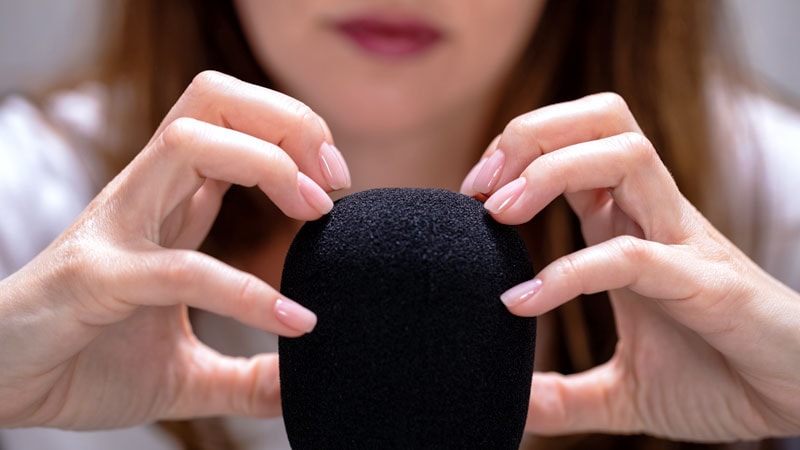Back in the ’80s, Craig Richard, PhD, would come home from school, sling off his backpack, and plant himself in front of the television to watch painter Bob Ross’ The Joy of Painting. Richard soaked in the gentle sounds of paintbrush on canvas as Ross conjured clouds and mountains and of the painter’s voice as he cooed words of encouragement. “This is your painting,” Ross would say. “Do what you want with it.”
“It made my brain just go all fuzzy,” Richard, a biopharmaceutical sciences professor at Shenandoah University and founder of the website ASMR University, told Medscape Medical News. “That’s why I used to watch him ― not because I wanted to learn how to paint, but because I found his voice, his actions, his sounds, his personality, his demeanor just so relaxing.”

Dr Craig Richard
Watching Ross was one of Richard’s introductions to the phenomenon now known as autonomous sensory meridian response (ASMR).
ASMR is characterized by tingling sensations, particularly in the scalp, caused by stimuli such as light touch and soft sounds. The internet illuminated and popularized ASMR and gave rise to content creators, dubbed “ASMRtists,” who aim to induce the feeling in their audience. Hundreds of thousands of internet users around the world have since claimed to find ASMR soothing, even therapeutic.
Unlike many viral trends that zoom across collective consciousness on a social media bandwagon, ASMR has remained popular for close to a decade. In 2019, YouTube estimated there were approximately 45 million ASMR videos on the site.
That same year, KFC ran an ASMR-themed ad campaign, and an ASMR commercial for Michelob Ultra aired during the Super Bowl. The Design Museum in London is set to host an ASMR exhibition that opens in May. And the fact that Ross — who is a cult television personality who died in 1995, rather than a YouTuber who was born in 1995 — remains one of the most well known, if unintentional, ASMRtists, suggests that the sensation was around long before it was given a complicated name and an online platform.
Still, the phenomenon remains largely shrouded in mystery. ASMR is a newly articulated feeling that may or may not have been felt since the dawn of civilization. The associated triggers and sensations are specific in form but divergent in expression. The experience is widespread enough to be viral online, but it is not universal. Most significantly, the evidence is anecdotally potent but scientifically nascent.
Could the unsolved mysteries of ASMR be obscuring its potential in the healthcare realm?
What Exactly Is ASMR?
In 2009, a woman named Jennifer Allen stumbled upon a thread on the online message board Steady Health titled “Weird Sensation Feels Good.” Commenters described a “silvery sparkle” and “in and out waves of heightened intensity” sweeping through their scalps. The thread sent a wave of recognition through Allen, who had been curious for years about an unnamed feeling she felt while watching videos of Earth from space.
Allen — now a cybersecurity professional and ASMR advocate — took it upon herself to brainstorm a name that might be taken seriously in clinical settings. She landed on “autonomous sensory meridian response.” The feeling is “autonomous” in the sense that it comes from within; it is “sensory” in that it seems to be the result of stimulated senses; “meridian” is a word for energy pathways in traditional Chinese medicine; and “response” denotes that the feeling is a reaction to certain stimuli.
Today, popular ASMR triggers — such as whispering, tapping, scratching, and brushing sounds and slow, sweeping motions — are often presented in simulations of healthcare scenarios, which make up one of the most popular categories of ASMR content. In her most-viewed video, Gibi ASMR, an ASMRtist with four million subscribers on YouTube, simulates dentist, eye, cranial nerve, sleep clinic, lice, and ear exams in rapid succession. In the past year, the video has drawn 36 million views and counting.
Less orthodox ASMR scenarios show ASMRtists feasting on an outsize portion of octopus (53 million views), applying makeup to an orange (13 million views), and a full-length ASMR adaptation of Bee Movie (5.7 million views).
A Self-Soothing Solution for Patients and Physicians
During the pandemic, trained physiotherapist Oliver Cotterill began making his own ASMR content under the name Ozone ASMR after noticing that much of the medically oriented content on YouTube was “not super accurate.”
“Because I have a bit more of an understanding of what the processes are, what language the professionals use, [and] because it’s so second nature,” he says, “I think [I have] that essence of confidence and that presence of authority…. That bedside manner is really important.”

Oliver Cotterill
The simulation of a medical interaction as a caring, stress-free, and even de-stressing experience may be why some people use ASMR content to self-soothe before heading to a dreaded doctor’s appointment, points out Guilia Poerio, PhD, psychology lecturer at the University of Essex and established ASMR researcher. But even the most fervent ASMR advocates warn that, owing to a lack of clinical evidence, ASMR should supplement medical treatment, not be a substitute for it.
“People seem to be self-medicating with ASMR, or using it to regulate their emotions,” Poerio says, “which is absolutely fine, but I don’t think we would ever want to recommend it as a substitute for actual proper treatment. And if we did, there would need to be some really good evidence for that.”

Dr Guilia Poerio
Even so, ASMR content offers an opportunity for healthcare professionals to be on the receiving end of a caring interaction after a long day of caring for others. “Healthcare professionals, like the patients they serve, also suffer from stress and sleep challenges,” Richard says. “The other irony is that they provide focused, caring, personal attention to others all day but may not be receiving similar caring behaviors.”
Cotterill, who provides care to others through both physiotherapy and ASMR content, watches other ASMRtists’ content in order to care for himself. “As a physiotherapist who provides manual therapies such as massage on a frequent basis, it is relieving to be on the receiving end of one, with ASMR role-plays being the next best option,” he says. “Viewing ASMR content remains a core component of my own personal self-care toolbox.”
Richard suggests that healthcare professionals not only watch ASMR videos but also seek real-world ASMR experiences, such as by asking loved ones to play with their hair or speak in quiet tones. Looking to the future, he says he predicts a rise of real-world ASMR practitioners who emphasize touch-based triggers.
In Poerio’s view, COVID-19 has minimized that possibility. She highlights other research questions concerning the future of ASMR: “Is it possible that people who haven’t experienced ASMR could experience ASMR? How can we use technology to enhance the experience?”
While these — and many other — questions remain unanswered, ASMR principles may already be relevant in healthcare settings. After all, the primary objective for healthcare professionals and ASMRtists alike is, in simplest terms, to make people feel better.
For many people — especially those struggling through the pandemic — feeling better is linked to feeling closer, if only through a laptop screen or a surgical mask.
Even when intimacy is an illusion, the comfort it provides can feel strangely real.
“I think as health professionals, we can learn from ASMR,” Cotterill says. “I would encourage others to incorporate some of the core aspects [of] ASMR videos…such as giving personal attention, active listening, [and] positive reinforcement.”
The Science Behind ASMR
ASMR videos prompt many people to experience a pleasant shiver across the scalp and down the spine, while others do not experience the feeling at all or do experience it but find it undesirable. A recording of someone chewing Doublemint close to a microphone, for example, may soothe some but make others recoil in horror.
“ASMR isn’t a simple feeling; it’s actually quite complicated,” Poerio tells Medscape Medical News. “So you have the kind of tingling response, which is a part of it, and that can kind of come in waves, and it’s almost kind of fuzzy. And that can be quite activating. People describe it as euphoric or blissful, and then you have that overall sense of relaxation.”
Poerio began researching ASMR after finding an abundance of ASMR content but a dearth of science to support it. In 2018, she conducted a two-part study along with fellow researchers from the University of Sheffield in the form of a large-scale online experiment and a laboratory study. In the online experiment, participants who watched a variety of ASMR videos reported “more frequent tingling, increased levels of excitement and calmness, and decreased levels of stress and sadness” in comparison to participants who watched non-ASMR videos. The laboratory study measured physiologic responses, which indicated that ASMR was associated with reduced heart rates and increased skin conductance levels. Both studies found that ASMR content “increased pleasant affect” in participants. Poerio and her fellow researchers concluded that ASMR was “a reliable and physiologically-rooted experience that may have therapeutic benefits for mental and physical health.”
A 2014 study, conducted by researchers from Swansea University utilizing an online questionnaire, found that 98% of respondents used ASMR content for relaxation purposes, 82% used it to get to sleep, and 70% used it for stress relief. The results also suggested that ASMR can temporarily alleviate depression. Poerio adds that people have reported using ASMR to manage their anxiety; as a way of “stimming,” or self-stimulating as a coping mechanism, in the case of individuals with autism spectrum disorder; and to help with feelings of loneliness. In other words, based on the current ASMR research, a mere whisper can speak to a variety of conditions.
Why Does ASMR Feel Good?
In early online discussions of ASMR, the feeling was often referred to as a “brain orgasm” or “brain-gasm.” Even in the years since it was given a name with more of a clinical sheen, skeptics have pointed out that ASMR content seems to carry a suggestion of eroticism.
ASMRtists — the most popular of whom are young, conventionally attractive women — whisper into microphones that correspond to each of their listener’s ears. They position themselves in close proximity to the camera, illuminated by mood lighting, as they float warm greetings and positive affirmations to the person on the other side of the screen. On the basis of current research, the strongest ASMR triggers appeal to the sense of touch, which, of course, cannot be directly replicated in a YouTube or TikTok video (yet). ASMRtists aim instead to stimulate a response through tactile sounds, such as acrylic nails scratching microphone foam or turning crisp book pages. They might slowly stroke the camera with their fingers or a peacock feather or a nail file. And the defining quality of ASMR is a physical “tingling” sensation.
ASMR may be sensual, but research suggests it is not an inherently sexual feeling. While 5% of participants in the Swansea Universit survey reported using ASMR content for sexual stimulation, 84% did not. “It may be physiologically arousing, but it’s not sexually arousing,” Poerio says. “I think this comes about because of the quite often socially intimate nature of the videos and that a lot of people can find them maybe quite creepy or quite cringey, but whether or not the content makes you feel sexually aroused is different to whether that feeling is ASMR.”
Some researchers link ASMR role play instead to the roles of mother and child. The atmosphere of ASMR has been described as “tranquil [and] womblike.” ASMRtists are typically trying to coax viewers to sleep, or at least to relax, through soft speech and gentle motions. “We have evolved to respond to [ASMR] from the day we were born,” Richard, who previously researched reproductive sciences at the University of Pittsburgh, tells Medscape Medical News. “Think of all the things you would do to comfort and soothe [an] infant. You would move gently and carefully, you would touch them lightly and carefully, you would gaze at them with care, you would talk softly, and you would give them this positive personal attention.”
Assumptions about eroticism and infantility in ASMR content reflect the fact that ASMR is built on fantasies of physical and emotional intimacy. “The context for all true ASMR triggers [is] receiving positive personal attention from another human that you feel comfortable with, or that you just don’t feel threatened by,” Richard says. “All true ASMR videos that stimulate the brain tingles have a person with this kind disposition, showing you something, teaching you something…. [In the] real world, those interactions happen between parents and children, between best friends. They happen between hairdressers and clients. And they happen between clinicians and patients.”
For more news, follow Medscape on Facebook, Twitter, Instagram, and YouTube.
Source: Read Full Article
